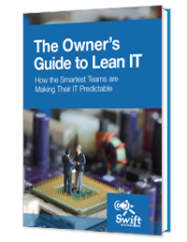
Growing your Business Through Multi-Site IT Networks
For a growing business, one location is typically not enough. With enough personnel and capital, many businesses prefer to set up multiple offices to attract different regions of customers.
The question becomes, with separate offices, how can your business install a network so all the locations can work, communicate, and share information easily, instantaneously, and effectively?
Technologies that allow this are changing daily. Just a few years ago, most consulting companies would recommend you install servers, databases, etc., all of which were capital expenditures that required a lot of time and large money investments.
Within the past year or so, new advancements in communication technology – including improvements to virtual private networks, remote desktops, and the cloud – allow instantaneous information and file sharing with an extremely cheap price tag.
At Swift Systems, a good percentage of our customers have multi-site networks. Swift can offer options ranging from a very simple solution for a business that has maybe one or two offices, to a much more robust solution for 10 offices all over the country. It’s just a matter of what you think is best for your business.
Here are some ways to make setting up your business’s new IT network smart, safe, and cost-efficient.
Choose a Mode of Communication
To connect many distant employees at once, all office locations must be able to access the same network resources. Most times, a home office would house the core infrastructure needed to establish the network, such as the servers and databases. Using a multi-site IT network approach, branch offices require no such infrastructure. The remote offices link to the home office via a specific type of connection.
A home office having only one Internet connection, however, can be problematic. If it goes down, it takes down every office. There are ways a business can alleviate the amount of downtime, such as having redundant Internet connections or failover servers that replicate from the home office to the branch offices. Traditionally, companies used to install Wide Area Networks (WANs) to connect remote offices. However, installation and overhead WANs is expensive.
VPNs, which provide secure connections between individual users and their organization’s network over the Internet, have several upsides for multi-site IT networks. They provide more secure site-to-site connections and they can provide much faster transfer speeds than traditional WAN links. Most importantly to small and medium-sized businesses, VPNs are much less expensive, since you can use a single leased line to the Internet for each office to cut down on broadband costs.
Enabled by the security and performance of VPNs, many companies are deploying remote desktop systems. Remote desktops allow applications to run remotely on a server, but displayed locally on the end user’s computer. This network server hosts remote files and applications in a secure location, ensuring your data is never lost, even when something happens to the device you’re working on.
Always keep security in mind
As with any technology, it’s important to make sure the security is locked down appropriately. A decade ago, open remote desktop ports were commonplace. Now, with hackers and automatic port scanners, these systems must be carefully protected.
Another key consideration for performance and uptime is having proper Internet connections. Swift usually recommends having at least one failover connection at the home office, and if possible, at the branch offices as well.
Consider Cloud Computing
The cloud is as handy as it is thrifty, because it can perform several functions that seriously simplify IT management for the company. The cloud offers 24/7 remote monitoring, anti-spam tools, e-mail archiving tools, remote data backup tools, desktop management technology, and workstation management tools, without the need for expensive on-site servers.
The old model was to install all of the business’s servers onsite, and having five to 10 servers wasn’t uncommon. Now, with virtualization, a lot of companies are virtualizing their servers into one server. This saves money, electricity, and IT engineering time.
Avoid dealing with the server headache
There are a lot of people, especially small businesses, that don’t want to deal with having a server anymore. Swift can offer hosting services for servers by virtualizing their servers internally at Swift’s data center. Businesses can access their servers via remote desktop over a VPN. That way, they don’t have to run their own servers. All they have to worry about is maintaining their Internet connection.
With more and more software systems being offered in the cloud, it offers a good solution to the multi-site network operations. For example, mail servers used to be commonplace in the enterprise or small business market. Now, with Office 365 and similar programs, it helps alleviate some of those problems. So, some of the services offered in the cloud can help with the multi-site network topology.
Companies today can exclusively use the cloud for all sharing purposes, but be warned: The cloud is not perfect. Although in most cases using the cloud is perfectly safe, there have been breaches that have popped up in the news. Hackers have broken into accounts of celebrities and stolen information.
At Swift, we only use trusted cloud vendors. Our data center is SSAE-16 certified and NIST 800-53 compliant. Federal agencies, medical practices, and many other organizations all house information in Swift’s cloud servers.
While the cloud may not be completely ready for singular use, most IT consultants agree that utilizing some form of cloud-based tools is absolutely essential to every new company. Look hard at the options that are out there now. If your company has a setup now that was set up five or 10 years ago, there might be a better option that cuts costs and provide better service and reliability.
Swift Systems is here to help your company in whatever way you think is best for your company. If it’s creating a multi-site IT network or if it’s setting up systems in the cloud, we’re here to give you guidance and support.

IT systems are foundational to modern businesses. Too often, that foundation is unsteady. Unpredictable outages, insecure networks, and unreliable performance from mission-critical systems can jeopardize your entire business.
There’s a better way. Learn how.
Get in touch with us for a free consultation with one of our technical experts. We’ll review your current systems, assess your needs, and identify the coverage options to best meet them.
Get in touch with us by phone:

